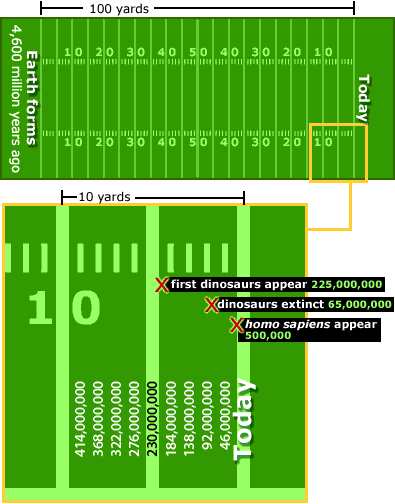|
Finding an Event in
Time
Many important events
have occurred since Earth formed 4,600 million years ago (mya).
Below is a list of some of those events. Your task is to mark on
a time line when those events took place. If
you haven't already done so, you might want to begin with the "Geologic
Time Activity." That activity provides a scale model of
a football field that can be used for this activity.
Mark the spot on the
time line with an "X"
where the following important events in Earth's history occurred.
- first microscopic
life (3.6 bya)
- first multicellular
life (900 mya)
- first oxygen appears
in atmosphere (1.9 bya)
- first land plants
appear (450 mya)
- formation of the Himalayas
begins (30 mya)
- formation of the Atlantic
Ocean begins (150 mya)
In the example below,
we have used the football-field model for our time line. On it we
have marked the first appearance of dinosaurs (225 mya), the
disappearance
of dinosaurs (65 mya), and the first appearance of homo sapiens
(1/2 mya).

Option: As a group
activity, it might be fun to create a geologic time line on the
floor of your classroom or a hallway. First, you will need to measure
the length of the place you have chosen to make your time line.
Second, determine how
many inches, feet, or yards represent a given number of years by
dividing 4.6 billion by the length of your "time line."
To mark the events in
Earth's history, you might prepare a sign representing each event
and have students hold the signs and stand in the proper time spots
on your geologic time line. (4.6 billion years is a big number to
represent. To prevent the need for "student-markers" to
stand on top of one another, you may want to use a very large space,
such as a gym or a sidewalk for your time line.)
Back
|











